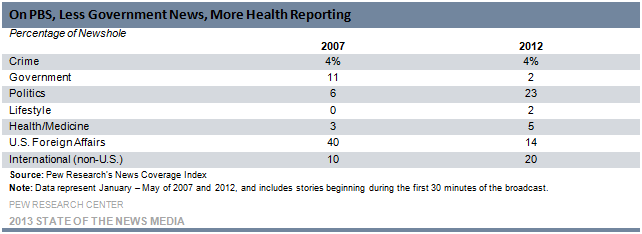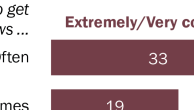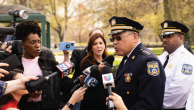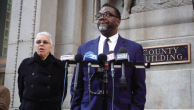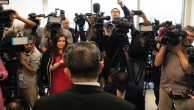The news programs that Americans watch on national cable channels and their local television stations have changed significantly in recent years while the network evening newscasts have remained remarkably stable, according to a new study from the Pew Research Center.
On cable, the news structure of the three channels—the mix of interviews, packaged segments and live coverage—has changed. After relying on significantly distinct formats five years ago, the three rivals now look strikingly similar.
At the same time, some of the differences that demarcated daytime cable from prime time have also eroded in the past five years. Traditionally known for its attention to breaking news, daytime cable’s cuts in live event coverage and its growing reliance on interviews suggest it may be moving more toward the talk-oriented evening shows. This transition may cut the costs of having a crew and correspondent provide live event coverage.
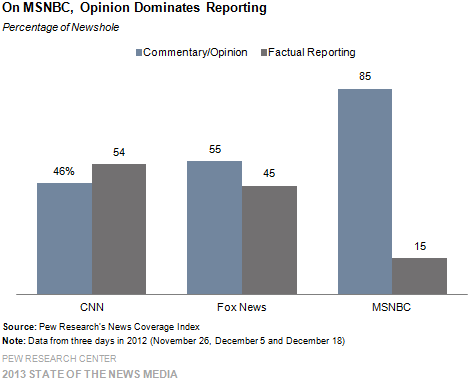
CNN, which has branded itself around reporting resources and reach, cut back between 2007 and 2012 on two areas tied to that brand—in-depth story packages and live event coverage. Even so, CNN is the only one of the three big cable news channels to produce more straight reporting than commentary over all. At the other end of that spectrum lies MSNBC, where opinion fills a full 85% of the channel’s airtime.1
In local television, newscasts in recent years have placed an even greater emphasis on traffic, weather and sports, reduced the number of edited package stories on the air and shortened the lengths of stories, trends that may reflect the economic strains affecting the industry.
With younger people tuning out local newscasts, there is growing concern that local TV news may be facing some of the financial challenges that have already battered the newspaper industry. And even as local TV newscasts seem to be doubling down on sports, traffic and weather, there are an ever increasing number of digital sources outside of television that provide that kind of information on demand.
The one television news platform that seems to be a rock of stability is network news. Despite the steady erosion of the early evening audience and continuing doomsday predictions about the future, the structure and format of the network newscasts have changed remarkably little since 2007, far less than on cable or local television news.
One change in content appears to be ABC’s growing tendency toward lifestyle subjects, contrasted with CBS’s movement the other way, toward more hard news. But for viewers, the most obvious difference between network news in 2007 and 2012 may be two new evening anchors, Diane Sawyer and Scott Pelley, sitting in the studios of ABC and CBS, respectively.
These findings are part of a broader examination of whether and how the structure of television news content—on cable, on broadcast network newscasts and on local television—has changed in the past few years. Pew Research studied the first five months of 2007 and 2012 for network and cable news, including both morning and evening network news and a mixture of midday and prime-time programming on cable. For local television, the comparative years are 2005 and 2012, for six stations in 2005 and eight in 2012.
Among the key findings:
- Interview segments are now as prominent in daytime cable as they are in prime time. Coverage of live events and live reports dropped in daytime programming by about one-third—from 33% of the newshole in 2007 to 23% in 2012. And the airtime devoted to interviews rose from 39% to 51%, equaling the percentage of airtime they fill on cable at night, when partisan talk and debate drive the programming.
- In 2007, CNN spent far less time airing interviews and far more time running edited packages than either Fox or MSNBC on prime time. But that had changed markedly by 2012. The percentage of CNN evening programming filled with interviews jumped from 30% in 2007 to 57% in 2012. At the same time, the airtime for edited packages plunged from 50% to 24%
- A separate analysis of cable in late 2012 finds that, over all, commentary and opinion are far more prevalent on the air throughout the day (63% of the airtime) than straight news reporting (37%). CNN is the only channel to offer more reporting (54%) than opinion (46%), though by a small margin. By far the highest percentage of opinion and commentary is on MSNBC (85% to 15% reporting). Fox was in between at 55% commentary and 45% reporting.
- The average story length on local television news decreased substantially over time. In a separate Pew Research Center analysis of local news content from 1998 to 2002, some 31% of the stories were more than a minute long and 42% were under 30 seconds. In 2012, only 20% of the local television stories exceeded a minute while 50% lasted less than 30 seconds.
- The already considerable amount of time devoted to sports, weather and traffic on local newscasts rose even higher in the snapshot of stations studied, from 32% 2005 to 40% in 2012. The biggest increase came in the airtime devoted to sports, to 12% from 7%. The traffic and weather components of the newscast increased by a smaller percentage (to 29% from 25%), but four in ten of the newscasts examined here led with a weather story.
- One measure of the unchanging nature of the broadcast network news format, particularly in the evening, is the story length. The average evening news story package lasted 141 seconds in 2007 and 142 seconds in 2012. The average interview was nearly identical as well: 110 seconds in 2007 and 108 in 2012. And the time allotted to the average stand-up report decreased only slightly, from 91 seconds to 88 seconds, in that five-year interval.
About This Study
For the historical data regarding the three cable news stations (CNN, Fox News and MSNBC), a large sample of weekday programming was examined during the first five months of 2007 and 2012. That sample included a half-hour sample of afternoon programming (2:00-2:30 p.m. Eastern Time) along with the first 30 minutes of many of the general news-focused programs during the evening hours. In order to make sure the half-hour sampling of afternoon cable news was representative of daytime cable news, Pew Research examined an additional three full days of cable in late 2012. The data from those three days suggest that the 2:00-2:30 p.m. time slot is representative of daytime programming in general.
For the first five months of 2012, Pew Research analyzed 6,472 stories over the course of 267 hours of cable programming (not including commercials or previews.) In 2007, Pew Research coded 9,655 stories over the course of 377 hours. When that is combined with the three-days of coding in late 2012, Pew Research analyzed a total of 711 hours of cable news, excluding commercials and previews.
For local television news, the comparison was primarily between 2005 and 2012 with some analysis from 1998-2002. Data from 2005 came from a previous Pew Research project called A Day in the Life of Media, which examined 24 newscasts from three markets (Milwaukee, Houston and Bend, Ore) from one day, May 11, 2005. From 1998 through 2002, the Project undertook an examination of local news in 15-20 markets a year, 154 stations. Those findings are used for certain comparative elements to 2012 such as story length For data from 2012, Pew Research examined eight stations – two each from four markets – over three days in late 2012 and early 2013.2 The same three markets used in 2005 were included, along with a fourth market, Pittsburgh, which was added to increase diversity. The two top-rated stations from each market were chosen based on Pew Research’s analysis of Nielsen Media Research data from all four sweep periods. One morning and one evening program from each station was identified. The times examined for all stations were 6:00-6:30 a.m. local time and either 10:00-10:30 p.m. local time or 11:00-11:30 pm local time, depending on what each station offered.
The 2012 local television news sample included 24 broadcasts, 1,055 stories and more than 15 hours of news programming (excluding commercials and previews). In 2005, the sample included 908 stories over almost 11 hours of programming. The 1998-2002 sample featured 154 stations and 33,911 stories over 1,200 hours of programming.
For network television news, Pew Research studied the first five months of 2007 and the first five months of 2012 on ABC, CBS and NBC along with the evening news program on PBS. The sample included the first 30 minutes of each of the three weekday commercial morning shows and entirety of the weekday commercial evening broadcasts. For PBS’s evening program, the first 30 minutes were included. The five-month 2012 sample of January through May included 4,942 stories over the course of 134 hours (excluding commercials and previews). The 2007 sample included 8,841 stories and 247 hours. Combined that accounted for 381 hours of network news programming.
Cable News: CNN, MSNBC and Fox Evolve
In 2012, the programming formats at the three cable news channels looked remarkably similar, a major change from 2007 when CNN was distinguished by its emphasis on edited packages and MSNBC spent far more time on interviews than either of its rivals.
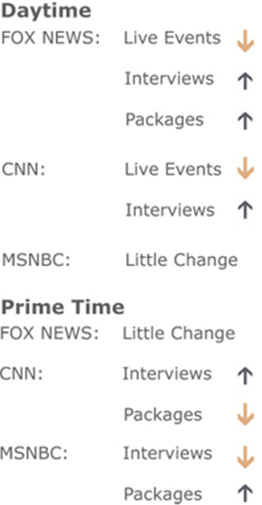
This convergence occurred after major shifts at all three networks. MSNBC changed its formatting most in prime time, Fox in daytime and CNN changed in both day parts.
In prime time, MSNBC made the key decision to reprogram itself as a liberal counterweigh to the Fox News Channel’s conservative nighttime lineup. The new MSNBC strategy and lineup were accompanied by a substantial cut in interview time and sharply increased airtime devoted to edited packages. But those packages are not what many would consider traditional produced pieces.
A separate Pew Research examination of programming in December 2012 found MSNBC by far the most opinionated of the three networks, with nearly 90% of its primetime coverage coming in the form of opinion or commentary. And that remains the case with many of its packaged segments. Host Rachel Maddow, for example, often begins her show with a lengthy segment combining a monologue with video clips that can last for seven minutes or longer.
At CNN, three staples of its often fluid evening lineup in 2007—Lou Dobbs, Paula Zahn and Larry King—are no longer there. Under CNN’s new president, Jeff Zucker, who took over in January 2013, the prime-time lineup could well shift again. But in the meantime, the network traditionally known for its emphasis on reporting resources and breaking news coverage has changed to become more like its rivals.
Between 2007 and 2012, the channel nearly doubled the percentage of airtime devoted to interviews, while almost halving the airtime allotted for story packages. In addition, coverage of live breaking events during the daytime hours was cut by more than half.
Fox, the long-time ratings leader, instituted little change in prime time over the past five years, either in personnel or programming structure. In the daytime programming examined, however, the network all but removed coverage of live news events, and increased both packaged segments and interview segments.
Cable News: Comparisons by Day
[3.The study included weekday programming 2:00-2:30 p.m. Eastern time. In order to make sure the half-hour sampling of afternoon was representative of daytime cables news in general, Pew Research examined an additional three full days of cable in late 2012. The data from those three days suggest that the 2:00-2:30 p.m. time slot is representative of general daytime programming.]
The decrease in coverage of live breaking events has been accompanied by a big increase in interviews, which are now as prevalent in the day as in prime time. This shift means that a good deal of on-scene reporting has been replaced with interviews, which, although they may be live, are far less expensive to produce and do not require a correspondent or crew.
Edited packages increased moderately in the daytime, but account for only about one-third as much airtime as the interviews. Both components of live events coverage during the daytime declined over the five-year stretch. Live breaking news was cut in half, from 10% in 2007 to 5% in 2012, and live staff reports dropped from 23% of the newshole to 18%. Combined, that means a 10 percentage-point drop in the amount of live-oriented daytime coverage that did not take the form of interviews with guests.
Those interviews increased from 39% in 2007 to 51% in 2012, representing an outright majority of the daytime programming. The percentage of newshole, or airtime, devoted to reported packages also increased, from 14% to 19%, but they account for a far smaller portion of the overall coverage. The results of these shifts mean that not only was as much time devoted to interviews on daytime as on prime time in 2012, but also that the once considerable gap between live event coverage in the day and evening has narrowed sharply. In order to ensure that our main sample of daytime coverage was representative, Pew Research also examined five hours of afternoon cable on three days in late 2012.
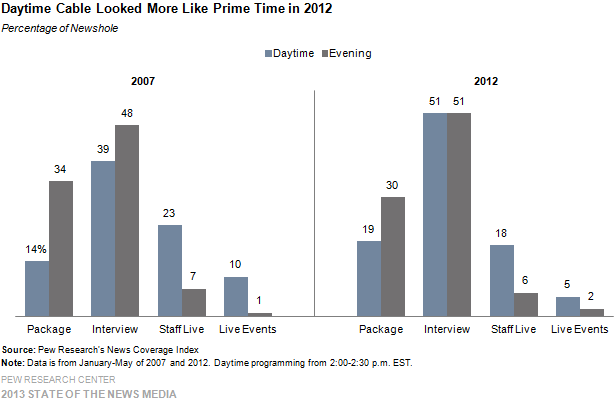
Conversely, the format of prime-time cable looks very similar in 2007 and 2012.3
The percentage of airtime devoted to interviews went up marginally, from 48% to 51% while packaged reports dropped modestly from 34% to 30%. The overall figures, though, mask significant changes at CNN and MSNBC that brought them closer in line with each other.
The next question is whether daytime’s growing similarities in format with prime time brought with it a growing degree of prime time’s opinionated content.
The separate Pew Research analysis of three days of cable coverage in late 2012 finds that the prime-time programming still features the most lopsided ratio of opinion to traditional reporting (70% of the newshole to 30%). But in the midday time slot studied, from noon until 3 p.m., opinion also outweighs straight news by a substantial margin—59% to 41%. In the early-morning programming, from 6 a.m. until 10, commentary also exceeds reporting, but by a slightly smaller margin—56% to 44%.

In prime time, opinion exceeds reporting at all three channels. Not so in the daytime. CNN maintains higher levels of straight reporting in both the morning and mid-day. Fox’s morning programming is a pretty even mix of reporting and opinion, with opinion overtaking reporting in mid-day. At MSNBC, opinion overwhelms reporting in both the morning and at mid-day.
Comparisons by Cable Channel
Fox News
In terms of programming, the top-rated Fox News Channel has been remarkably stable in prime time. The only personnel changes that occurred in the evening between 2007 and 2012 were Bret Baier replacing Brit Hume at 6 p.m. and the departure of liberal co-host Alan Colmes at 9 p.m., leaving his conservative sparring partner, Sean Hannity, as the sole host of the show.
The format mix also barely budged. Packages remained at about a third of the time (31% in 2007 to 34% in 2012), interviews at just under half (48% to 46%), live events changed little (1% to 3%) and live staff reports stayed exactly the same (7%).
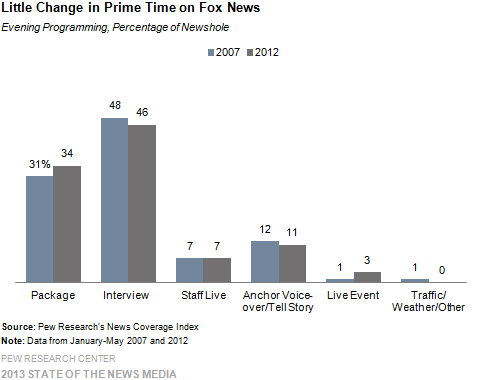
Daytime, though, was a different story. Coverage of live events plunged from 13% in 2007 to only 1% in 2012, the greatest drop-off in live event coverage of the three top channels. That was countered by a substantial increase in packaged reports, from 14% in 2007 to 23% in 2012. And as was the case at all three channels, the newshole allotted to interviews in the daytime also jumped, from 39% in 2007 to 52% in 2012.
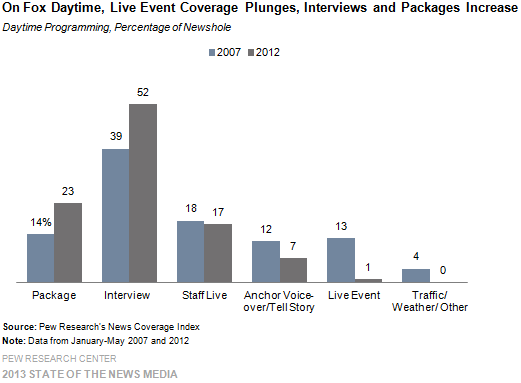
MSNBC
Given the current liberal approach at nighttime at MSNBC, it’s hard to remember that back in 2007, the prime-time airwaves were split between liberals (Keith Olbermann and, to a lesser extent, Chris Matthews) and conservatives (Joe Scarborough and Tucker Carlson). Now, Al Sharpton, Rachel Maddow and Ed Schultz are linchpins in an ideologically reconstructed liberal lineup.
In prime time, the biggest change in programming structure at MSNBC was a significant increase in the time devoted to packaged stories and a corresponding decrease in the newshole allotted to interviews. In 2007, packages accounted for only 13% of the MSNBC evening airtime studied; by 2012 it had risen to 31%. At the same time the once-overwhelming dominance of interviews (75%) in 2007 had fallen to 52% in 2012.

Five years ago, MSNBC’s mix of packages and interviews made it an outlier among the three cable networks. The shift reflected in the 2012 numbers puts it much closer to its competitors in terms of format.
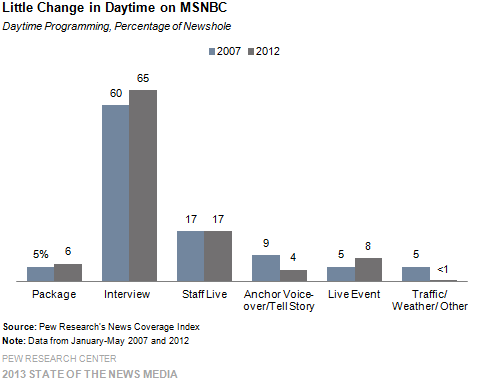
Still, the increasing reliance on packaged segments on MSNBC in prime time does not translate into more straight news reporting. For example, host Rachel Maddow often leads her program with a long package filled with her own opinions on a subject. Indeed, the Pew Research analysis of three days of cable coverage in December 2012 finds that opinion and commentary overwhelms straight news—86% to 14%—on the network’s prime time programs. That is the highest percentage of prime-time opinion of any of the three channels.
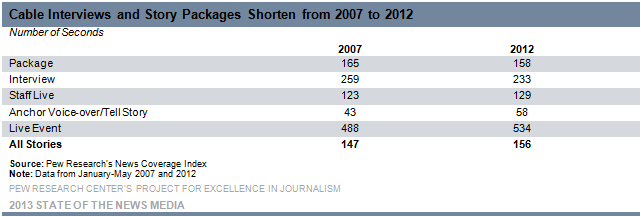
In the reverse of Fox, the major changes in MSNBC’s prime-time programming stand in stark contrast to the stability in daytime. There the airtime devoted to packages increased slightly, from 5% in 2007 to 6% in 2012. Interviews moved up slightly, from 60% to 65%, while live staff reports stayed exactly the same, at 17%. One area in which MSNBC moved against the larger trend was in a modest increase in live event coverage in the daytime. That accounted for 5% of the newshole in 2007 and increased to 8% five years later.
CNN
CNN, which now ranks last among the big three cable channels in both daytime and nighttime viewership, has traditionally been plagued by prime-time programming problems and constantly shifting lineups. Of the current hosts and anchors, only two—Wolf Blitzer and Anderson Cooper—were on the air in 2007. The failure of CNN to solve its nagging prime-time issues has led some observers to assert that in the current cable climate, a channel that chooses not to be overtly liberal or conservative is doomed in the ratings battle.
The arrival of former NBCUniversal CEO Jeff Zucker clearly portends major programming and personnel changes at the network. And some of that has already happened with the hiring of Jake Tapper and Chris Cuomo from ABC and a reported shakeup in the morning show.
But an analysis of CNN content in 2007 and 2012 indicates that before Zucker got there, the channel had already shifted some of its prime-time priorities, most notably by cutting its edited packages in half and roughly doubling the time devoted to interviews. In 2007, interviews in prime time accounted for only 30% of the newshole at CNN, far less than at both Fox and especially at MSNBC. By 2012, that gap had been eliminated as the airtime devoted to interviews nearly doubled, to 57%. Indeed, that is now the highest percentage of interview time on the three channels.
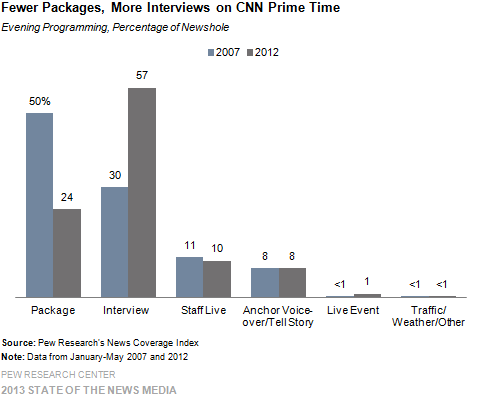
In 2007, edited packages accounted for 50% of CNN’s evening coverage—far ahead of MSNBC and Fox. In 2012, that was nearly halved—to 24% eliminating the gap with its rivals.
In the daytime coverage studied, CNN also doubled the airtime for interviews, from 17% in 2007 to 35% in 2012. Unlike that in prime time, however, the newshole for packages in daytime also increased, from 23% to 28%. But two elements of live daytime coverage plunged at CNN. The newshole for live staff reports dropped from 34% in 2007 to 18% in 2012, while live event coverage decreased from 11% to 5%.
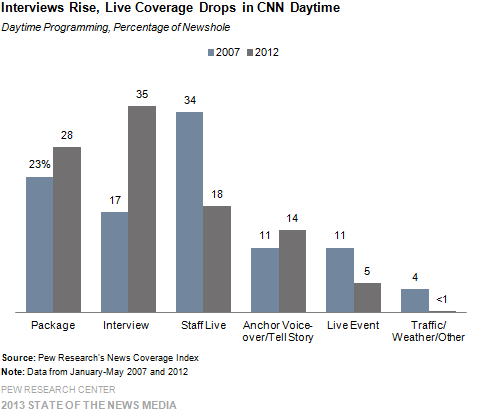
Combined, then, coverage of live daytime events, other than interviews, plunged from 45% of CNN’s daytime lineup five years to 23% in 2012, cutting that programming in half.
Top Stories in Cable
It is a challenge comparing the cable news agendas in the first five months of 2007 and 2012 because so much of the coverage is dependent on events. But there are several trends that emerge when looking at some of the biggest cable storylines in both years.
One thing Pew Research has learned from studying cable content is that political topics tend to dominate the news agenda, far more than in the news media over all. In the first part of 2007, two such subjects—the early stages of the 2008 presidential campaign (10% of the newshole) and the Washington Beltway-based partisan policy debate over Iraq war strategy (14%) were the two biggest stories, combining to account for about one-quarter of all the coverage studied.
In the first part of 2012, the presidential campaign overwhelmed ever other topic in the news on cable, accounting for 41% of the newshole. That is about six times as much coverage as the No. 2 story during that time period—the controversy surrounding the shooting of unarmed Florida teen Trayvon Martin (7%).
When looking at coverage by individual cable channel, there are a few patterns that hold true in both 2007 and 2012. One is that MSNBC, which calls itself the “place for politics,” had by far the heaviest emphasis on political coverage, both in 2007 (before the switch to an all liberal prime-time lineup) and in 2012.
For one thing, in 2007, MSNBC devoted the most coverage of any cable channel (22%) to the Iraq policy debate and by far the most coverage (17%) to the 2008 presidential campaign. (Fox was next at 9% in campaign coverage.) Two other political stories—the controversy over the public identification of CIA operative Valerie Plame (4%) and the firings of some U.S. attorneys around the country (7%) — received the most attention on MSNBC.
In 2012, MSNBC devoted more than half of all the coverage studied to the presidential campaign (57%). That was much more attention than the campaign received on Fox (37%) and almost twice as much as it got on CNN (30%).
The other network that distinguished itself in certain topic areas was CNN, primarily for its coverage of overseas events. In 2007, CNN’s attention to the fighting and situation in Iraq (7%) was more than double that of either of its competitors.
In 2012, that focus on international stories manifested itself in the most coverage of any cable channel on the continued unrest and bloodshed in the Middle East. That subject accounted for 9% of the CNN newshole, triple the volume of coverage on both Fox and MSNBC.
Looking at the broader categories of coverage, the CNN tendency toward more overseas news remains. In 2007, foreign stories accounted for 30% of CNN’s newshole, compared to 21% on Fox and 25% on MSNBC. Five years later, CNN still had the edge—23% foreign coverage compared to 15% on Fox and only 7% on MSNBC, which if anything, has become even more focused on domestic political stories in the past five years.
Local Television News: Shrinking Pains
The changes in local television news in recent years may reflect some growing economic strains on the industry. In 2012, local affiliates for Fox, ABC, NBC and CBS lost more than 6% of their audience in the important early morning, evening and late night slots. And even with record high spending on political advertising in 2012, ad revenue for local television stations was well below the levels of the last decade.
Some of these problems seem to be manifesting themselves on the content side. When data from 2012 is compared with stations studied in 2005 and earlier, the amount of time devoted to edited story packages has decreased and average story lengths have shortened, signs that there is less in-depth journalism being produced. Traffic, weather and sports—the kind of information now available on demand in a variety of digital platforms—seems to be making up an ever-larger component of the local news menu, according to the stations studied in 2005 and 2012. Coverage of politics and government, meanwhile, was down by more than 50%.
Part of the decrease in edited packages and story lengths may reflect the fact that with local stations continuing to add news programming, particularly in the morning, editorial resources are stretched thinner. In 2011, the last year for which data exist, stations aired a record 5 hours and 30 minutes of local news on weekdays in 2011, or 12 minutes more per week than the previous year.
News Agenda
In a comparison of the topics covered in local news broadcasts studied in 2005 with a sample of newscasts from late 2012 and early 2013, sports, weather and traffic grew to where they now fill 40% of the airtime.
According to a Pew Research survey conducted in 2011, some 58% of adults said they turned first to local TV news for weather. It was also the preferred platform for getting traffic news, although for a much smaller percentage of people. This report suggests that local news has built up a third leg to these two core elements of local television news. In addition to the more modest increase in the already substantial amount of airtime filled by weather and traffic—from 25% in 2005 to 29% in 2012, among the stations studied—the time devoted to sports nearly doubled, from 7% of the newshole in 2005 to 12% in 2012.
Thus, when sports, traffic and weather are combined, the airtime time devoted to these subjects rose from 32% of local TV newscast studied to 40% of local TV newscasts studied—a 25% increase. Indeed, Pew Research’s examination of 48 evening and morning newscasts in late 2012 and early 2013 found that 20 of them (or 42%) led with a weather report or story.
At the same time, several significant areas of local news coverage have diminished.
Crime stories have traditionally been among the largest component of local newscast, but in the two periods studied, there was a marked reduction. In 2005, crime accounted for a full 29% of the newshole. Five years later, that number had fallen to 17%.
The same basic trend was seen in coverage of politics and government. In 2005, those topics accounted for 7% of the airtime studied. By 2012/2013, that coverage had been more than halved—to 3% of the airtime. For some time, television consultants have been advising local television stations that viewers aren’t interested in politics and government, and it appears that advice is being taken.
Over the same time, there has been significant growth in several other topic areas. The airtime devoted to accidents, disasters and unusual events increased from 5% in 2005 to 13% in 2012/2013. One possible reason for that jump is the increased use and sophistication of satellite technology that makes it easy to air compelling or eye—catching video from anywhere in the world. Another is that viewers are often encouraged to share their video of dramatic events.
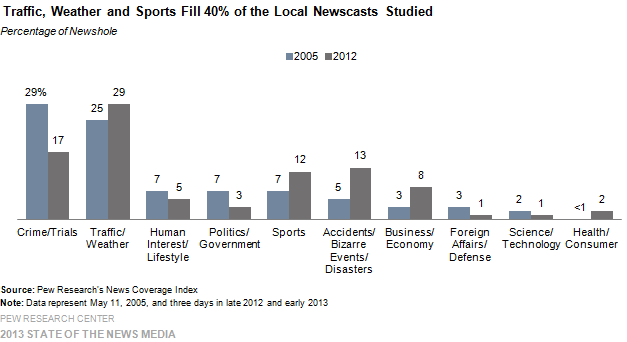
And given the impact of the deep recession that struck in 2012, coverage of business and the economy almost tripled from 2005 to 2012/2013. In that period, it rose from 3% of the newshole—where it was behind accidents and disasters, politics and government and human interest and lifestyle stories—to 8% of the newshole.
Changes in Format/Programming
One notable change in the construction of the local newscast in the past few years is a roughly 20% decrease in airtime allotted to packaged stories. According to the 2005 data, those packages accounted for 41% of the local television newshole. In 2012, that was down to 33%.
The time allotted to anchor voice-overs slipped modestly from 24% in 2005 to 21% in 2012.The amount of time devoted to interviews was negligible in both 2005 (2%) and 2012 (0%).
Other than the increase in the fixed segments devoted to traffic, sports and weather–the one local news format that has seen growth is the live staff report, which entails sending cameras and reporters to the scene of an event. The airtime devoted to those reports jumped from only 1% in 2005 to 6% in 2012.
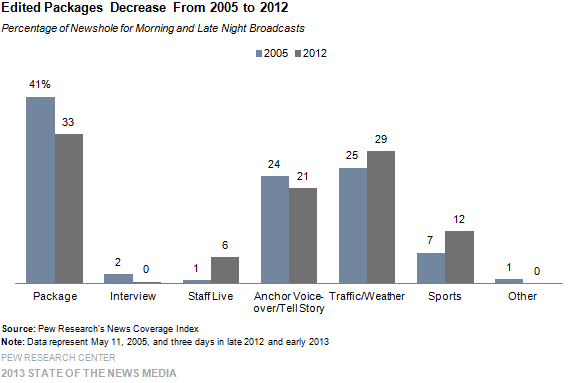
Local News: Format by Day Part
Those programming trends in local TV news are evident in both the early morning and late night newscasts studied. In the morning, the time devoted to edited packages dropped from 29% to 19% from 2005 to 2012. The same was true at night, with packages slipping from 58% of the newshole down to 44%.
At the same time, the reliance on traffic and weather segments increased from 33% to 39% in the morning over those seven years and from 15% to 21% at night. Sports coverage has also become an increasingly large component in both time slots. In the morning newscast, coverage doubled from 3% to 6% of the newshole. At night, it rose from 13% to 16%.
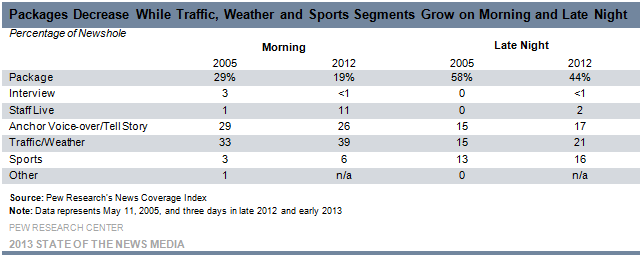
Whether local television’s increased reliance on those areas of news will continue to pay dividends as digital news consumption grows, particularly on a range of mobile devices, is a significant question for the industry moving forward.
Story Lengths
Another sign that in-depth enterprising reporting is on the downswing in local TV news is the shrinking length of stories over time.
According to an earlier study of local television news from 1998-2002, some 31% of all the stories excluding traffic, sports and weather were more than a minute long while 42% were under 30 seconds in length.4 In 2012, the percentage of stories over a minute long shrunk to 20% while the percentage of those less than half a minute grew to 50%.
A further breakdown of all the stories examined in 2012 reveals that the story packages—less frequent than before on local TV news—averaged one minute and 15 seconds in length. The average live staff report was 44 seconds and the average anchor voice-over lasted 25 seconds.
Network Television: Steady as She Goes
For years, some pundits and naysayers have been saying that network television news must change substantially in order to alter a grim trajectory. They cite, among other things, an aging demographic, (the average evening news viewer is 53), the loss of half the total audience in the past three decades and the anachronistic idea of appointment news viewing in an era of information on demand. And one area of change has been at the evening anchor desk, where two of three anchors—ABC’s Diane Sawyer and CBS’s Scott Pelley—assumed their jobs in recent years.
But aside from that, network news—and especially the evening newscasts that attract a combined audience of about 22 million Americans each night—has remained an island of stability in an otherwise rapidly transforming media environment. An examination of the format and content of these newscasts in the first half of 2007 and the first half of 2012 finds remarkably few alterations to the network news formula.
Network Comparisons by Day Part
Evening News
By far, the dominant component of the ABC, CBS and NBC evening newscasts is the edited and highly produced package report. And that has not changed in recent years.
In 2007, more than three-quarters of the airtime on the nightly newscasts (82%) studied by Pew Research was composed of package reports. Five years later, that percentage had fallen only slightly, to 79%.
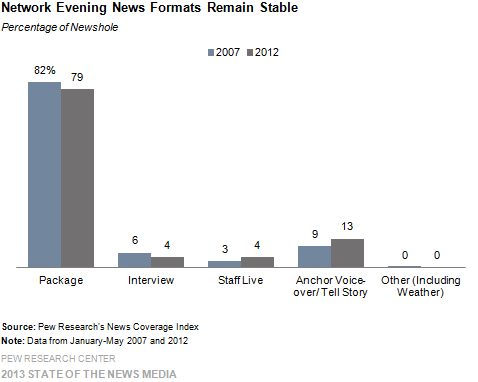
The use of other story formats stayed stable as well, from 2007 to 2012. The biggest shift came in the growing amount of airtime given to anchor voice-overs in 2012 (13%) compared with 2007 (9%)
Not only was there little change in the reliance on packaged reports, but the length of each of these reports remained remarkably steady. Five years ago, the average package on the evening news lasted 141 seconds. In 2012, that had increased by one second. A much smaller component of the evening newscast, the interview, dropped in length by an average of only two seconds in the past five years—from 110 seconds in 2007 to 108 in 2012. And the length of an average live stand-up report decreased modestly, from 91 seconds in 2007 to 88 in 2012.
Because the stories of the network newscasts are dependent on events having just occurred, it is harder to discern patterns in the network news agendas in 2007 and 2012. Last year, for example, the two biggest topics for network news were the presidential election and the economy’s slow recovery from recession. In 2007, there was no recession and the presidential election was in its early phases.
Even so, in other categories less tied to continuing events, there was little substantial change in the amount of coverage from 2007 and 2012. For example, the coverage of government, which does not include political campaigns, accounted for 6% of the evening newshole in both 2007 and 2012. Coverage of crime went up modestly from 7% of the newshole in 2007 to 9% in 2012, and some of that difference might be chalked up to coverage of the shooting of Florida teen Trayvon Martin.
The volume of coverage of softer topics, such as lifestyle and celebrity, was similar in 2007 (9%) and 2012 (7%).
Morning News
While there are significant differences in the evening and morning newscasts, the formats of the networks’ early news shows, like their evening counterparts, have remained remarkably stable in the past five years.
The reliance on packaged stories, which dominate, but not to the degree they do in the evening, changed little. In 2007, they accounted for 51% of the airtime studied compared with 53% in 2012. The amount of time devoted to interviews, the No. 2 component of the morning newscast, diminished only slightly, from 29% to 27%.
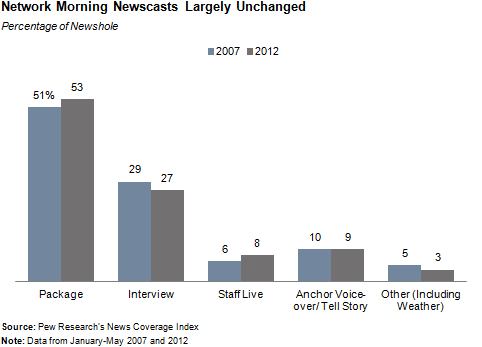
Compared to the nightly newscasts, there have been bigger shifts in the length of stories and segments on the morning news from 2007 to 2012. Edited packages grew from 137 seconds to 151 seconds in five years. But in two other areas, the lengths have decreased. The average interview lasted 137 seconds in 2012 compared with 176 in 2007 while the time allotted to live staff reports plunged by about 50%—from 104 seconds to 54 seconds.
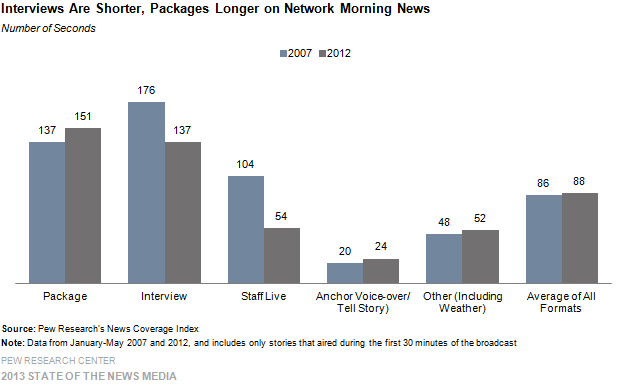
Comparing the news agendas of the morning shows in 2007 and 2012 reveals some understandable differences. Coverage of elections jumped from 14% of the newshole in 2007 to 24% in an election year. Crime coverage also increased from 9% to 14%, due largely to the extensive coverage of the killing of Florida teen Trayvon Martins, which was the second– biggest storyline for morning news in 2012.
But in other cases, there was little or no distinction between the amounts of coverage devoted to key topics in 2007 and 2012. Attention to business and economics was at 5% in both years; stories about government accounted for 6% in 2007 and 5% five years later. Celebrity and lifestyle coverage dropped from 9% to 6%.
One area where things did change is the amount of time devoted to the news produced by the national broadcast in its first half hour. That rose by more than a minute, from 16 minutes and 47 seconds in 2007 to 17 minutes and 58 seconds in 2012. One reason for that was that all three networks reduced the time allotted to local affiliate cut-ins for news and weather reports.
Comparisons by Network
Looking at the format and structure of the evening news on a network basis reinforces the idea that there has been only incremental change.
In 2007, for example, 69% of the overall newshole for ABC’s morning and evening shows was filled with edited packages. That increased slightly to 73% in 2012. At NBC, those numbers were virtually the same, 63% versus 64%. And at CBS, there was a modest decrease from 70% to 67%.
One format that saw an across-the-board, albeit small, jump was the amount of time allotted to anchor voice-overs. At ABC, that rose from 10% in 2007 to 11%. At NBC, it increased from 10% to 13% and on CBS, the change was from 7% to 10%.
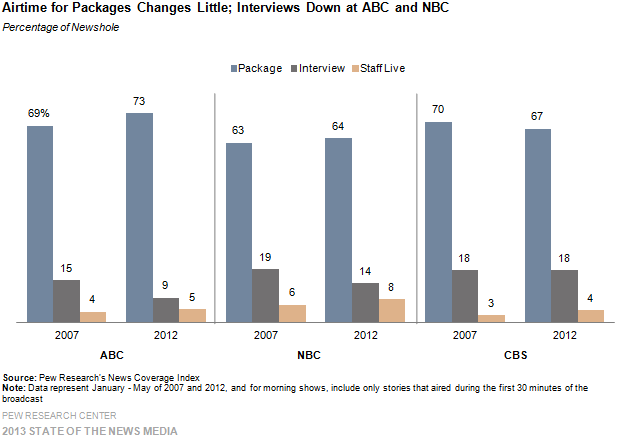
At the individual network level, there were only small differences in the average length of various story packages. The length of a package dropped slightly at ABC, from 143 seconds to 140 seconds, from 2007 to 2012. But it grew at both CBS (135 to 141) and at NBC (141 to 155). One clear across the board trend was the reduction in length of the average interview from 160 to 116 seconds at ABC, from 158 to 139 at CBS and from 155 to 130 at NBC.
But these changes in story lengths are largely due to shifts in story lengths on the network morning shows. In the evening, there was considerably less change from 2007 to 2012.
Looking at the news agenda by network, we find some topics where there was little change in volume of coverage from 2007 to 2012. When it came to coverage of government, there was a reduction at ABC from 6% to 4%, while the volume remained steady, at 6%, for both CBS and NBC. Attention to health and medical issues also changed little. At ABC, coverage increased from 6% to 7% while dropping slightly at CBS (7% to 6%) and rising slightly at NBC (5% to 6%).
But in other coverage areas, there is evidence of some change in news priorities from 2007 to 2012. At ABC, where observers have noted a growing tendency to focus in on softer news topics, coverage of lifestyle and celebrity stories grew from 7% to 12% from 2007 to 2012. Coverage of crime on the network jumped from 8% to 14%.
Conversely, at CBS, which has publicly declared its interest in focusing on more hard news, the coverage of lifestyle and celebrity topics dropped significantly—falling from 11% in 2007 to 2% in 2012, the least amount of coverage of any of the big three networks.
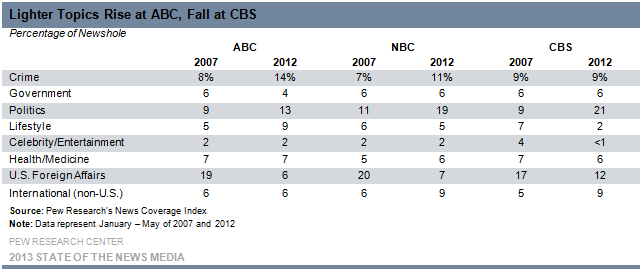
PBS NewsHour
With its interview-heavy format, the PBS nightly NewsHour newscast is constructed very differently from those of the three commercial networks. But its basic format, too, has changed little from 2007 to 2012.
When considering the first 30 minutes of its broadcast, in 2007, packaged pieces filled 38% of the NewsHour’s airtime and that remained exactly the same five years later. The newshole devoted to interviews did rise modestly from 49% to 54%, and that was accompanied by a decrease in the amount of time spent on anchor voice-overs, which fell from 12% in 2007 to 7% in 2012.
The NewsHour did produce some changes in the lengths of stories from 2007 to 2012. The duration of an average package jumped 44 seconds, but there was a decrease of nearly a minute (55 second) in the average length of the program’s interviews.
The NewsHour’s news agenda also shifted in some significant topic areas from 2007 to 2012. Coverage of government dropped from 11% to 2% while coverage of business and economics jumped from 4% to 14%. Another area of reduction was overseas coverage, which accounted for half the program’s newshole (50%) in 2007, but fell to about one-third (34%) in 2012. At least part of that can be attributed to the fact that the raging debate over U.S. policy in Iraq, and especially President George W. Bush’s surge decision, was a major continuing story in 2007.
